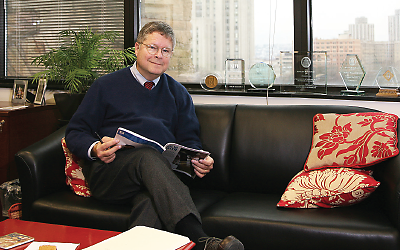DSM-5 Sleep-Wake Disorders Section Targets Comorbidity
Abstract
The DSM-5 sleep-wake disorders section includes disorders that are not mental disorders because they often co-occur.

Sleep-wake disorders may be a sign of a developing mental disorder, says Charles Reynolds, M.D.
The classification of sleep-wake disorders in DSM-5 aims to help psychiatrists, mental health clinicians, and general medical clinicians diagnose and treat sleep-wake complaints. It also offers guidance on when to refer a patient to a sleep specialist for further assessment and treatment planning, Charles Reynolds III, M.D., chair of the DSM-5 Sleep-Wake Disorders Work Group, told Psychiatric News.
The sleep-wake disorders section encompasses 10 disorders or disorder groups that prompt patients to complain of unsatisfactory quality, timing, and amount of sleep, often accompanied by daytime distress and impairment.
Since sleep-wake disorders present in different ways at different ages, the section provides diagnostic criteria across the lifespan, said Reynolds, an endowed professor in geriatric psychiatry and director of the Aging Institute at the University of Pittsburgh Medical Center.
“Sleep is of the brain, by the brain, for the brain,” Reynolds asserted. “It is a fundamental operating state of the central nervous system and central to overall health and well-being.”
Brain circuits that regulate mood are close to those that regulate sleeping, waking, and arousal. Treating sleep-wake disorders, he said, may promote brain health and cognitive fitness and prevent cognitive disorders.
The sleep-wake disorders section includes disorders that are not mental disorders, such as narcolepsy, sleep-related breathing disorders, and restless legs syndrome. That’s because depression, anxiety, and cognitive impairment often accompany such disorders, Reynolds said. DSM-5 distinguishes narcolepsy, known to be associated with hypocretin deficiency, from other forms of hypersomnolence.
Sleep-wake disturbances may be a tipoff to underlying medical and neurological disorders, Reynolds noted, including congestive heart failure, Parkinson’s disease, and Alzheimer’s disease, and may exacerbate these disorders.
As DSM-5 states, “coexisting clinical conditions are the rule, not the exception.” Sleep-wake disturbances at a physiological as well as a behavioral level, Reynolds noted, may be a marker for developing mental disorders. They also may contribute to alcohol and other substance use and abuse and may be associated with use of medications for various illnesses.
The Sleep-Wake Disorders Work Group aimed to boost recognition of the bidirectional relationship between mental disorders and sleep-wake disorders and the need for comprehensive treatment, Reynolds said.
“When I treat a depressed patient who gets better but still complains of insomnia, I know my job is not done,” he said. “If I don’t treat the insomnia, my patient is at risk for relapse.”
This understanding led to a fundamental shift away from the previous classification of insomnia as primary or secondary, he said. The new insomnia disorder section includes comorbid mental disorders and physical conditions that should be addressed in treatment.
The sleep-wake disorders section also includes circadian rhythm sleep-wake disorders, such as delayed and advanced sleep-phase disorders associated with irregular schedules and shift work. Unlike DSM-IV-TR, DSM-5 does not include jet lag. DSM-5 also covers parasomnias—abnormal events occurring in sleep or sleep-wake transitions—and nightmare disorder.
Work group members sought to incorporate polysomnographic and other validated laboratory-based measures into diagnostic criteria. The use of biological markers, Reynolds said, may help clinch the diagnosis in ambiguous clinical cases.
“Our neuroscience needs to go further,” Reynolds stated. ■



